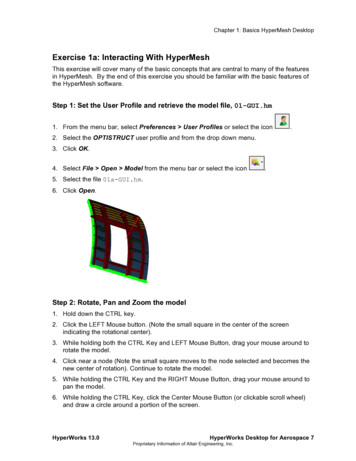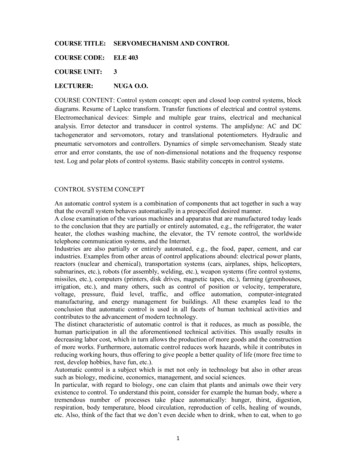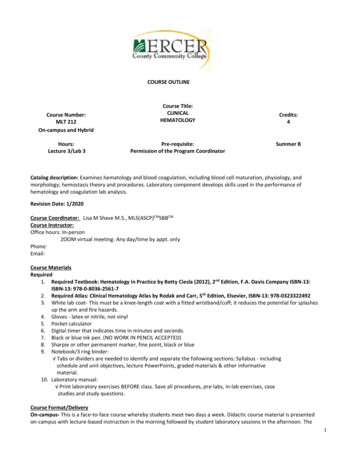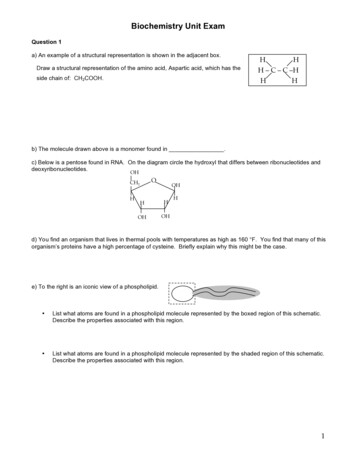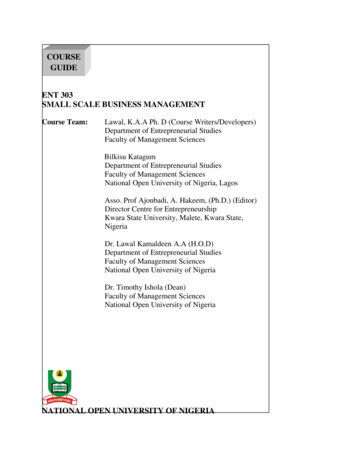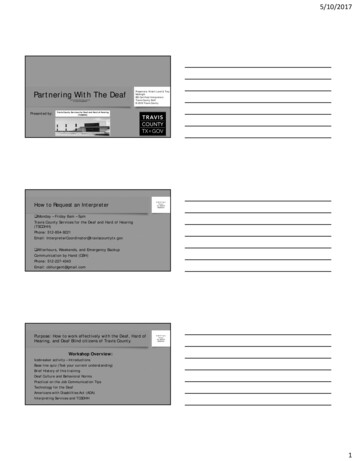
Transcription
5/10/2017Partnering With The DeafCommunity 2016 Travis CountyALL RIGHTS RESERVEDPresented by:Presenters: Kristin Lund & TreyMcKnightBEI Certified InterpretersTravis County Staff 2016 Travis CountyTravis County Services for Deaf and Hard of Hearing(TCSDHH)How to Request an Interpreter 2016 TravisCountyALL RIGHTSRESERVED Monday – Friday 8am – 5pmTravis County Services for the Deaf and Hard of Hearing(TSCDHH)Phone: 512-854-9221Email: InterpreterCoordinator@traviscountytx.gov Afterhours, Weekends, and Emergency BackupCommunication by Hand (CBH)Phone: 512-227-4343Email: cbhurgent@gmail.comPurpose: How to work effectively with the Deaf, Hard ofHearing, and Deaf Blind citizens of Travis County. 2016 TravisCountyALL RIGHTSRESERVEDWorkshop Overview:Icebreaker activity – IntroductionsBase line quiz (Test your current understanding)Brief History of this trainingDeaf Culture and Behavioral NormsPractical on the Job Communication TipsTechnology for the DeafAmericans with Disabilities Act (ADA)Interpreting Services and TCSDHH1
5/10/2017Ice Breaker Activity 2016 TravisCountyALL RIGHTSRESERVEDIntroductions: Name Current Position Share one experience you have had with a Deaf,Hard of Hearing, or Deafblind person Anything in particular you would like to learn bythe end of the dayDeaf and Hard of Hearing Statistics 2016 TravisCountyALL RIGHTSRESERVED 10% of the US population has some sort hearing loss 357,574 out of15,858,474 Texans are Deaf or Hard of Hearing 2.3% Austin is estimated to have a much larger Deaf and Hard ofhearing population due to TSD, Texas school for the Blind,tuition waver, accessible universities, etc. You will interact with Deaf, Hard of hearing, and Deafblind.Three very different groups requiring different knowledgebases to serve.DeafnessQuiz1.Deaf people usually have other disabling conditions.2.Lip-reading is a skill most deaf people have.3.“Hearing impaired” is term that is considered highly offensive to members of the Deaf Community.4.The Deaf community has its own distinct culture and behavioral norms.5.Look directly at the interpreter when speaking to a Deaf person.6.State and national certification enable an interpreter to interpret for any situation.7.Being fluent in Sign Language qualifies you to interrogate a Deaf suspect.8.Writing notes is an effective means of communication.9.Hearing aids improve a deaf person’s communication.10.American Sign Language is the only language Deaf people use.11.The ADA requires that the expressed choice of the individual with the disability should be given primary consideration in determiningif they need an interpreter.12. 2016 TravisCountyALL RIGHTSRESERVEDUsing family members or friends to interpret helps, because they know of the history and are more readily available.13.What are three steps you should take when providing equal access communication?14.If a Deaf individual starts out writing notes but later requests an interpreter are you obligated to provide an interpreter?15.Summarize your department’s process for requesting a sign language interpreter?2
5/10/2017 2016 TravisCountyALL RIGHTSRESERVEDHistory of Travis County Deaf Training 1994 Deaf man lost in court system for 3 months 2002 Deaf Blind couple arrested at Restaurant leads tofederal civil rights suit 2009 Esther Valdez case – Deaf tackled by office after failingto hear officers verbal instructions 2009 City of Austin settles federal civil rights suit. Mandatesofficers receive training on how to effectively communicatewith the deaf See HandoutsDeaf Experience in Prison 2016 TravisCountyALL RIGHTSRESERVED“Prison within a Prison" Advocates for deaf prisoners refer to the isolation experienced bydeaf prisoners as a “prison within a prison.” Many deaf prisonersexperience prolonged communication deprivation that leads tomental health conditions and to these prisoners losing their abilityto socialize and communicate with anyone in any language. Thisholds true even for deaf prisoners housed in the generalpopulation.LINK18:05 - EndIncidental Information Hearing people have access to “incidental information” all thetime. They overhear conversations, they hear comments andremarks on the radio and television. Even background noisescount as incidental information. How might this impact your work in the field? What should youdo?3
5/10/2017Deaf or Hearing Impaired? 2016 TravisCountyALL RIGHTSRESERVED “Deaf” is a term used to reference a member of theDeaf community or Deaf Culture. They are proud to beDeaf and feel Deafness is a vital part of their identity, asmuch as ethnicity, gender, or religious background. “Hearing impaired” is term that is considered highlyoffensive. It is an outdated way to collectively labelpeople with any level of hearing loss. This term can beinterpreted as oppressive and meaning that something iswrong with them, that something needs to be fixed. Sowhat is correct? It is preferable to use the specific termsof Deaf or Hard of Hearing.Deaf Culture Primary language is ASL– Recognized language with its own rules of grammar and syntax English and ASL are NOT the same thing! Consider possibilityof ESL (English as a Second Language) circumstancesDeaf Culture: Behavioral Norms 2016 TravisCountyALL RIGHTSRESERVED1. Attention-Getting and Touchhttps://youtu.be/l9aNpMRHH2c (Start at 10min)2. Eye Contact3. Turning Away4. Taking another’s hand5. Use of Light to Gain Attention6. Leave-taking in the Deaf Community7. High Context Culture4
5/10/2017How Deaf People Communicate?Sign Language 2016 TravisCountyALL RIGHTSRESERVEDWritten notesLip readingWriting Notes 2016 TravisCountyALL RIGHTSRESERVEDLip reading and speech 2016 TravisCountyALL RIGHTSRESERVEDBad Lip Reading Video: https://youtu.be/W-kGosnzvjU5
5/10/2017Communication Tips (Part 1) 2016 TravisCountyALL RIGHTSRESERVED Don’t rely on family members to interpret Make sure you have the deaf persons attention before you attempt tocommunicate anything Speak to the deaf person not the interpreter Do not let an object obstruct the deaf persons view of you while youcommunicate Find a well-lighted place to communicate if possible Do not exaggerate your lip movements Speak clearly but don’t raise your voice. Shouting distorts both soundand lip movements making things more difficultCommunication Tips (Part 2) 2016 TravisCountyALL RIGHTSRESERVED Be sensitive to whether a Deaf person is understanding you or just being polite andnodding without following what you are saying. Try to use Deaf technology if possible (VRS in the home is permitted in emergencysituations) Be direct with your communication. Hearing English formalities do not translate well.(Ex. Sandwich Technique) Avoid misunderstandings based on perceived meaning in a Deaf persons facialexpressions or signing. If someone cannot understand you, write a note asking what communication mode isbest for their situation. Understand that some deaf people do not read or write English– ASL is its own language with no roots in English – and may push a notepad away if thisis the case.History of Deaf Identifiers 2016 TravisCountyALL RIGHTSRESERVED Old Symbols usedto identify the Deaf Positioned Deafpeople to be takenadvantage of6
5/10/2017 2016 TravisCountyALL RIGHTSRESERVEDSpecialty License Plates The license plate’s name in the TxDMV’s motor vehicledatabase is “Deaf Driver Awareness.” This license platename will appear when an officer looks-up or calls in aplate-look-up during a traffic stop. Its important that the plate’s design NOT alert thegeneral public that the motorist is deaf, but bespecifically designed to indicate to law enforcement thata driver is deaf or hard of hearing. Additional note: This license plate program will not be utilized by all. This is a tool only.Communication impediment program 2016 TravisCountyALL RIGHTSRESERVED The Texas Transportation Code §521.125 allows the TexasDepartment of Public safety to include a notice on a state driver’slicense or identification card for persons who indicate they have ahealth condition that may impede their ability to communicatereadily to a law enforcement officer. Additional Note: This program is not required, and many deaf individuals do not have this designation on theirdriver license. Use this as a tool only, not as an absolute.Basic Signs Gestures & Online Resources Deaf Help Hurt Drivers License Insurance Are you ok? No Yes Stop 2016 TravisCountyALL RIGHTSRESERVEDOnline ASL ny other signs you would like to know?7
5/10/2017 2016 TravisCountyALL RIGHTSRESERVEDhttps://www.youtube.com/watch?v NhO2cpmmmo&feature c4-overviewvl&list icans with Disabilities Act 2016 TravisCountyALL RIGHTSRESERVEDThe ADA requires that title II entities (State andlocal governments) and title III entities (businessesand nonprofit organizations) communicateeffectively with people who have communicationdisabilities. The goal is to ensure thatcommunication with people with these disabilitiesis equally effective as communication with peoplewithout disabilities. They may not be excluded orsegregated from services.Effective Communication according to the ADA 2016 TravisCountyALL RIGHTSRESERVEDFor people who are deaf, have hearing loss, or aredeaf-blind, this includes A qualified sign language interpreter Tactile interpreter (Deaf-Blind) Real-time captioning (Hard of Hearing) In some cases written materials. Don’t assume you know what is best. Ask theindividual what is most effective for them.8
5/10/2017Who Decides What is Effective? 2016 TravisCountyALL RIGHTSRESERVED The ADA requires that the expressed choice ofthe individual with the disability, who is in thebest position to know his or her needs, should begiven primary consideration in determining whichcommunication aid to provide. Agencies cannot charge the person for thecommunication aids or interpreting services Only agency head (or designee) can determine ifproviding interpreting services is undue burden.UbiDuo 2016 TravisCountyALL RIGHTSRESERVED Example of Text to Texttechnology Can be an effective way tocommunicate for Hard of Hearingwith fluency in English Remember ADA! The individualrequiring accommodationdetermines what is anappropriate accommodation forthem. Be prepared to call for aninterpreterInterpreters 2016 TravisCountyALL RIGHTSRESERVED Certifications:State and National Ethics/roles:Adhere to strict set of professional ethics established by certifying ofessional-conduct/ Different linguistic needs for different clients:Not all interpreters have the same skill set CDI-specialized interpreter: Certified Deaf Interpreter Different role – focus on consumer comprehension Work in tandem with hearing interpreters9
5/10/2017Requesting InterpretersInformation to provide when making interpreter requests Intake Detention Probation Court Meetings with attorney Home/school visits Classes Treatment Community Service Orientation On-site arrival/calls Follow up questions/interviews If in doubt Setting DetailsNature of the requestGender requirements orrequestsExpected durationPoint of ContactDeaf Persons Name (Screen for Conflicts)Details (Note: the more detailsyou provide the betterpositioned an agency will be toprovide the interpreter youneed.Take advantage of our Deaf and HOH Case Management teamfor additional inmate support. Request a visit – appointmentsto Dell Valley are on Fridays.Case Management Services for after inmatesare released: 2016 TravisCountyALL RIGHTSRESERVED 2016 TravisCountyALL RIGHTSRESERVEDRequest Case Management for currentinmates: Tom Turnertom.turner@traviscountytx.gov2201 Post Road #100Austin, TX 78704TCSDHH Office hours: 8AM-5PMWalk in Appointments WelcomeTravis County Services for the Deaf andHard of Hearing 2016 TravisCountyALL RIGHTSRESERVED TCSDHH is a dynamic, responsive agency that strives to bridge the gapsbetween deaf, hard of hearing, and hearing citizens in the Travis Countyarea. Services at a glance: Case Management, Crisis Intervention, Assistancewith legal system, Advocacy, Information and referral, Notary services,Interpreting services, Outreach/education to City of Austin & TravisCounty Departments, Adaptive equipment for deaf persons with lowincome, Computer Assisted Real Time Captioning (CART) for Travis Countyfunctions on request, Public station for video phone calls10
5/10/2017Deaf Blind 2016 TravisCountyALL RIGHTSRESERVED Cane Etiquette Fear and Frustration (What does it look like) How to communicate an emergency Print on Palm (Don’t lift finger) Anchor Don’t move personal items Video –https://youtu.be/0L CNzDtLgUActivity: Group Harvest 2016 TravisCountyALL RIGHTSRESERVED Imagine you are a Deaf person coming intocontact with your department. List all of thepotential struggles (regarding communication oraccess) you might encounter while interactingwith your group. What are potential solutions (oraccommodations) to the issues you haveidentified? Be prepared to share your findings!ADA Law Enforcement Resources: 2016 TravisCountyALL RIGHTSRESERVEDU.S. Department of Justice Civil Rights Division - Disability Rights Section: Communicating with People Who Are Deaf or Hard of Hearing ADA Guide for Law tm MODEL POLICY FOR LAW ENFORCEMENT ON COMMUNICATING WITH PEOPLE WHO ARE DEAF ORHARD OF HEARING http://www.ada.gov/lawenfmodpolicy.htm COMMONLY ASKED QUESTIONS ABOUT THE AMERICANS WITH DISABILITIES ACT AND LAWENFORCEMENThttp://www.ada.gov/q%26a law.htm11
5/10/2017Additional Resources 2016 TravisCountyALL RIGHTSRESERVED ACLU, olice-interaction HEARD, http://www.behearddc.org/ National Association of the Deaf, http://nad.org/ Texas Association of the Deaf, http://www.txad.org/ Texas Dept. of Assistive and Rehabilitative Services(DARS), es 2016 TravisCountyALL RIGHTSRESERVED Americans with Disabilities Act (ADA), www.ada.gov DEAF Inc., “Deaf Sensitivity Training Video for Police Officers,”http://deafinc.org Texas Department of Motor Vehicles, Vehicle Titles and RegistrationDivision, Specialty License Plates U.S. Department of Justice, Civil rights Division, “Communicating withPeople who are Deaf or hard of Hearing,”http://www.ada.gov/lawenfcomm.htm Gallaudet hp?pid 119476&sid 102919012
ADA Requirements: Effective Communication1 of 5https://www.ada.gov/effective-comm.htmU.S. Department of JusticeCivil Rights DivisionDisability Rights SectionEffective CommunicationThe Department of Justice published revised final regulations implementing the Americans with Disabilities Act (ADA) for title II(State and local government services) and title III (public accommodations and commercial facilities) on September 15, 2010,in the Federal Register. These requirements, or rules, clarify and refine issues that have arisen over the past 20 years andcontain new, and updated, requirements, including the 2010 Standards for Accessible Design (2010 Standards).OverviewPeople who have vision, hearing, or speech disabilities (“communication disabilities”) use different ways tocommunicate. For example, people who are blind may give and receive information audibly rather than in writing andpeople who are deaf may give and receive information through writing or sign language rather than through speech.The ADA requires that title II entities (State and local governments) and title III entities (businesses and nonprofit organizationsthat serve the public) communicate effectively with people who have communication disabilities. The goal is to ensure thatcommunication with people with these disabilities is equally effective as communication with people without disabilities.This publication is designed to help title II and title III entities (“covered entities”) understand how the rules for effectivecommunication, including rules that went into effect on March 15, 2011, apply to them.The purpose of the effective communication rules is to ensure that the person with a vision, hearing, or speech disabilitycan communicate with, receive information from, and convey information to, the covered entity.Covered entities must provide auxiliary aids and services when needed to communicate effectively with people who havecommunication disabilities.The key to communicating effectively is to consider the nature, length, complexity, and context of the communication andthe person’s normal method(s) of communication.The rules apply to communicating with the person who is receiving the covered entity’s goods or services as well as withthat person’s parent, spouse, or companion in appropriate circumstances.Auxiliary Aids and ServicesThe ADA uses the term “auxiliary aids and services” (“aids and services”) to refer to the ways to communicate with people whohave communication disabilities.For people who are blind, have vision loss, or are deaf-blind, this includes providing a qualified reader; information inlarge print, Braille, or electronically for use with a computer screen-reading program; or an audio recording of printedinformation. A “qualified” reader means someone who is able to read effectively, accurately, and impartially, using anynecessary specialized vocabulary.For people who are deaf, have hearing loss, or are deaf-blind, this includes providing a qualified notetaker; a qualifiedsign language interpreter, oral interpreter, cued-speech interpreter, or tactile interpreter; real-time captioning; writtenmaterials; or a printed script of a stock speech (such as given on a museum or historic house tour). A “qualified”6/2/17, 10:40 AM
ADA Requirements: Effective Communication2 of 5https://www.ada.gov/effective-comm.htminterpreter means someone who is able to interpret effectively, accurately, and impartially, both receptively (i.e.,understanding what the person with the disability is saying) and expressively (i.e., having the skill needed to conveyinformation back to that person) using any necessary specialized vocabulary.For people who have speech disabilities, this may include providing a qualified speech-to-speech transliterator (a persontrained to recognize unclear speech and repeat it clearly) , especially if the person will be speaking at length, such asgiving testimony in court, or just taking more time to communicate with someone who uses a communication board. Insome situations, keeping paper and pencil on hand so the person can write out words that staff cannot understand orsimply allowing more time to communicate with someone who uses a communication board or device may provideeffective communication. Staff should always listen attentively and not be afraid or embarrassed to ask the person torepeat a word or phrase they do not understand.In addition, aids and services include a wide variety of technologies including 1) assistive listening systems and devices; 2)open captioning, closed captioning, real-time captioning, and closed caption decoders and devices; 3) telephone handsetamplifiers, hearing-aid compatible telephones, text telephones (TTYs) , videophones, captioned telephones, and other voice,text, and video-based telecommunications products; 4) videotext displays; 5) screen reader software, magnification software,and optical readers; 6) video description and secondary auditory programming (SAP) devices that pick up video-describedaudio feeds for television programs; 7) accessibility features in electronic documents and other electronic and informationtechnology that is accessible (either independently or through assistive technology such as screen readers) .Real-time captioning (also known as computer-assisted real-time transcription, or CART) is a service similar to court reportin
Classes Treatment Community Service Orientation On-site arrival/calls Follow up questions/interviews If in doubt Requesting Interpreters Information to provide when making interpreter requests Setting Details Nature of the request Gender re
